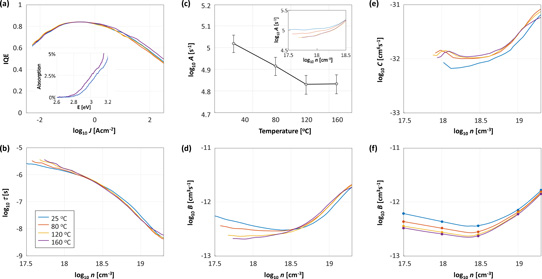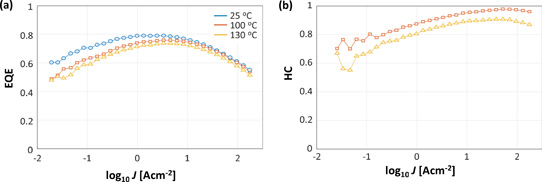News: LEDs
9 January 2020
Thermal droop in indium gallium nitride light-emitting diodes
A study of indium gallium nitride (InGaN) light-emitting diodes (LEDs) suggests that the thermal droop in external quantum efficiency (EQE) is mainly caused by transport effects such as carrier overshoot, according to researchers at Soraa Inc in the USA [Aurelien David et al, Appl. Phys. Lett., vol115, p223502, 2019].
Thermal droop refers to the loss in efficiency when the junction is heated either by high-temperature operation or due to poor heat dissipation in continuously operating devices (‘Joule heating’). This is in contrast to current droop, which refers to an efficiency loss at high current injection. Often current droop is isolated by pulsed operation designed to avoid heat build up in LED junctions.
The researchers used material grown by metal-organic chemical vapor deposition (MOCVD) on c-plane bulk GaN. The light emissions came from 13% indium-content InGaN single or multiple quantum wells (SQW/MQW). The use of expensive bulk GaN substrates gives best-case devices with low defect levels that should reduce leakage currents through dislocations.

Figure 1: PL measurements of thermal droop on SQW sample: (a) IQE, (b) differential lifetime versus carrier concentration. (c) Extracted SRH coefficient A. Inset: non-radiative current divided by carrier density: A value extracted from low-current plateau. (d) Radiative coefficient B. (e) Auger coefficient C. (f) Calculated value of B (considering many-body effects and alloy disorder) shows trend qualitatively similar to experimental data of (d).
Photoluminescence (PL) experiments on a SQW in the 25-160°C temperature range suggested a peak internal quantum efficiency (IQE) of 84%. The structure that was tested consisted of the SQW lodged in 200nm of intrinsic GaN material. The IQE response to the laser pumping was fairly consistent across the temperature range. The researchers even suggest that, allowing for differences in absorption, the peak IQE increased slightly at higher temperatures.
The researchers used an optical differential lifetime technique to derive the various parameters of the standard ABC model. The separate terms of the model – Shockley-Read-Hall (A), radiative (B) and Auger (C) – can be extracted by studying the luminescence at different carrier levels generated by different pump laser powers.
The team explains: “A diode laser having a time-dependent output excites the QW resonantly; the PL signal is collected by an avalanche photodiode connected to a network analyzer, which determines the phase and amplitude response of the PL signal, from which the differential carrier lifetime is derived. This technique directly probes the carrier lifetime in the active region and therefore circumvents transport effects.”
Analysis of the carrier lifetime behavior allows extraction of the current-dependent ABC coefficients, along with IQE.
The total recombination lifetime was found to be only weakly dependent on temperature with the ‘A’ portion attributed to non-radiative Shockley-Read-Hall (SRH) transitions through mid-gap levels slightly decreasing at high temperature against expectations, according to the researchers’ analysis based on the ABC model.
The team suggests that temperature-dependent effects reported previously can be attributed to two factors: “(1) in heteroepitaxy samples, additional dislocation-related effects may lead to a different thermal activation (especially for A); (2) previous studies have derived lifetimes from EL [electroluminescence] measurements, where recombination effects and transport effects were not disentangled. Our measurements directly probe active-region recombinations in low-defect material and therefore provide a more direct insight into the intrinsic nature of thermal droop.”
The researchers believe therefore that thermal droop in their LEDs’ EL performance is not due to recombination problems in the active QW region of the devices. The SQW LEDs consisted of 30nm p-i-n structures with a magnesium-doped aluminium gallium nitride (AlGaN) electron-blocking layer. The LED was assembled with the chip flipped onto a silver p-contact. One aim of the silver contact was high light extraction efficiency, presumably through reflection back to the top of the device.
Thermal droop is attributed to transport effects, such as electrons escaping from the active region by crossing the electron-blocking layer into the p-contact layer and recombining non-radiatively. The researchers performed a time-resolved study that allowed measurement of carrier escape time from the QW. The exponential temperature dependence was consistent with thermionic emission.
The researchers found that an optimized MQW structure enabled higher EQE and hot/cold (HC) ratio values (Figure 2). ‘Cold’ refers to room-temperature performance. The team observes that the HC ratio “reaches near-unity at a temperature of 100°C and at operating current density—a higher value than typically observed in commercial LED samples. Crucially, this improvement in the HC ratio is not obtained at the expense of peak EQE (instead, the room-temperature peak EQE of the MQW structure reaches a state-of-the-art value of 80%, surpassing that of the SQW structure). This reveals that thermal droop is not a fundamental limit to LED performance.”

Figure 2: Electroluminescence thermal droop in MQW LED: (a) EQE and (b) HC ratio.
The team suggests that the MQW structure reduces escape from the active region into the p-contact region. If the electron is not captured by one QW it may be by the next. However, there may also be a compensation effect going on, where higher temperatures enable broader use of the QWs in the MQW structure. Some studies have found that the MQW structures under EL testing have very non-uniform emissions, with most light coming from wells near the p-end of the device, since holes tend to have more sluggish transport properties.
This compensation may partially explain the HC performance, but not that of the EQE. The SQW LEDs showed a relative drop in peak EQE of 15% at 100°C, compared with 5% for the MQW structure. The researchers claim that the drop is not influenced by carrier spreading since it is the peak EQE being considered, regardless of current). The team adds that this “indicates that a majority of the HC improvement has a separate cause.”
InGaN LEDs GaN Thermal droop MOCVD
https://doi.org/10.1063/1.5124123
The author Mike Cooke is a freelance technology journalist who has worked in the semiconductor and advanced technology sectors since 1997.








